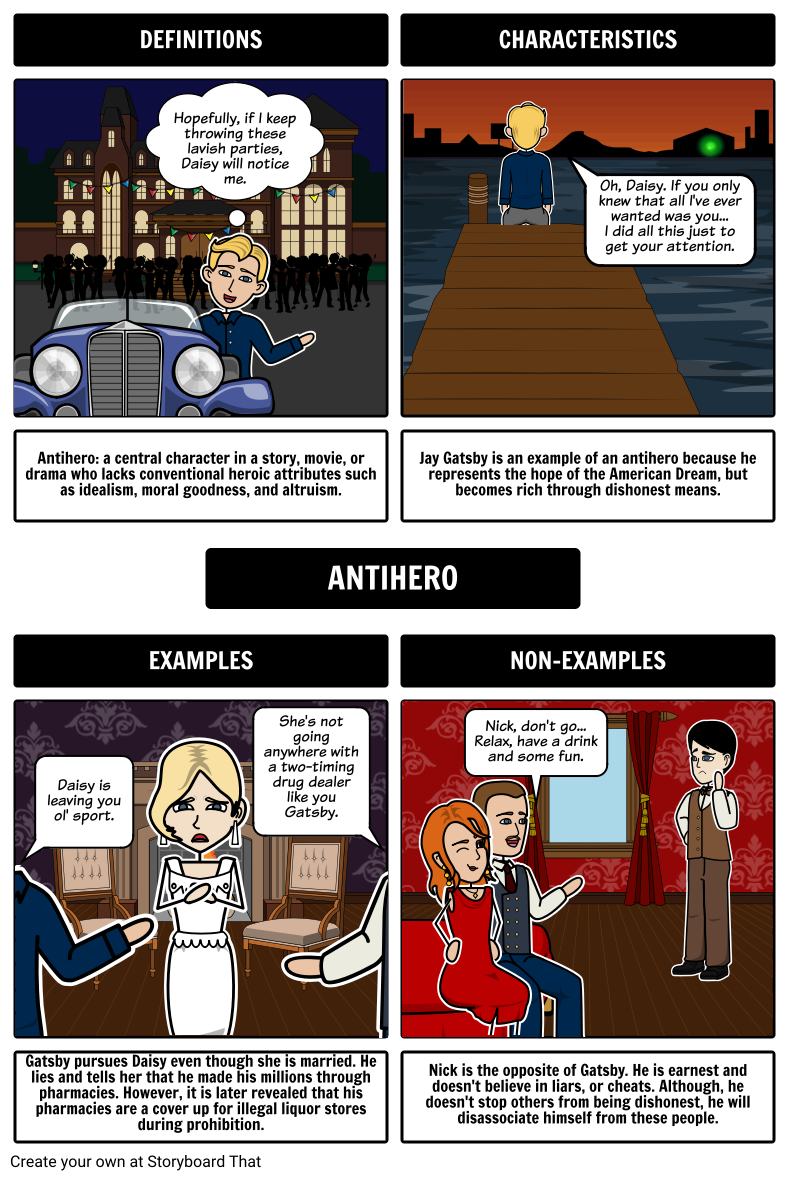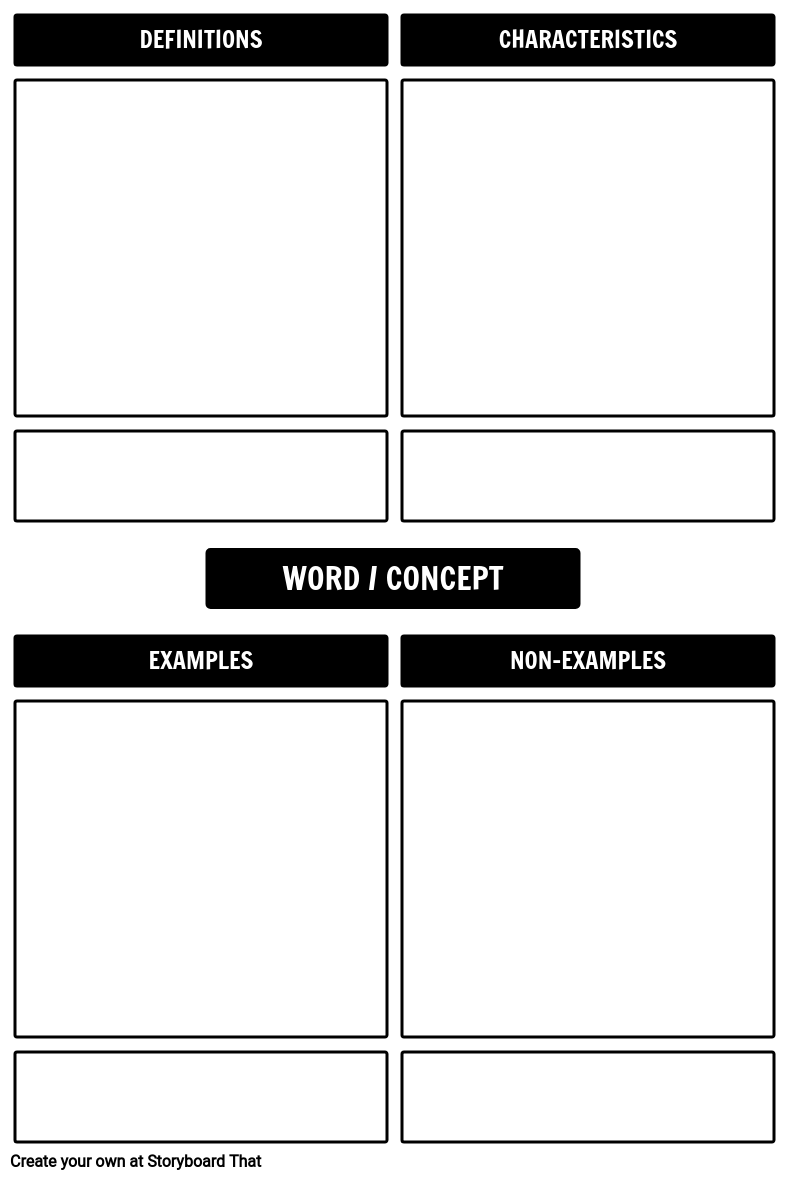Lesson Plan Overview
Uncovering the motivations of a protagonist, and understanding different archetypes in fiction is an important part of literary appreciation. In The Great Gatsby, Jay Gatsby is considered an antihero. Students can create storyboards that track the protagonist's actions, and support categorizing him as an antihero.
An antihero is a central character who lacks conventional attributes that would make them “good”. Gatsby seems like a good person, but he achieved his wealth through illegal means, he has lied to Daisy about who he is, and he has an adulterous affair with her. For front-loading terms and a lesson plan, see our article on antiheroes.
Have students create a Frayer Model for the term 'antihero', specifically relating Jay Gatsby from the novel. Students can use the traditional Frayer Model categories, Definition, Characteristics, Examples and Non-Examples, or select four quotes or events that support Gatsby as an antihero.
Template and Class Instructions
(These instructions are completely customizable. After clicking "Copy Activity", update the instructions on the Edit Tab of the assignment.)
Student Instructions
Create a Frayer Model that shows how Jay Gatsby can be considered an antihero.
- Identify events of the story or characteristics of Jay Gatsby that fit into attributes of an antihero.
- Illustrate examples for Definition, Characteristics, Examples and Non-Examples.
- Write a short description below each cell that specifically relates Jay Gatsby as an antihero.
Lesson Plan Reference
Student Rubric
(You can also create your own on Quick Rubric.)
| Proficient 25 Points | Emerging 21 Points | Beginning 17 Points | Try Again 13 Points | |
|---|---|---|---|---|
| Character Traits | Character is thoroughly described and accurately portrayed as an antihero using multiple adjectives. | Character description is clear but lacks details and has limited descriptive words. | Character description lacks clarity and/or detail, and may not be completely reflective of an antihero. | Character chosen does not fit the description of an antihero, or character chosen does not have enough information to score. |
| Influence on Story | Character is shown to have significant influence on respective story and other characters. | Student states why the character is appealing to them, but may need more solid information on why this is so. | Student either does not explain character appeal, or does not provide sufficient details. | Character’s influence is incorrectly explained, or project is not complete enough to score. |
| Use of Quotes | Multiple quotes have been used, are representative of an antihero, and are organized efficiently. | Quotes were used, but do not produce strong proof that the character is an antihero. | One quote is used, and does not efficiently or acceptably convey the character’s traits. | Incorrect quote was used, or no quote was used. |
| Presentation | Maximum effort is displayed, storyboard is exemplary, trivial or no errors are noted | Student shows decent effort in the creation of the storyboard, editing was performed, and few errors are noted. | Student produced a satisfactory story board, but it may lack visual appeal, contain errors, or has missing parts. | Presentation needs improvement, is incomplete, or poor effort was put forth. |
Lesson Plan Overview
Uncovering the motivations of a protagonist, and understanding different archetypes in fiction is an important part of literary appreciation. In The Great Gatsby, Jay Gatsby is considered an antihero. Students can create storyboards that track the protagonist's actions, and support categorizing him as an antihero.
An antihero is a central character who lacks conventional attributes that would make them “good”. Gatsby seems like a good person, but he achieved his wealth through illegal means, he has lied to Daisy about who he is, and he has an adulterous affair with her. For front-loading terms and a lesson plan, see our article on antiheroes.
Have students create a Frayer Model for the term 'antihero', specifically relating Jay Gatsby from the novel. Students can use the traditional Frayer Model categories, Definition, Characteristics, Examples and Non-Examples, or select four quotes or events that support Gatsby as an antihero.
Template and Class Instructions
(These instructions are completely customizable. After clicking "Copy Activity", update the instructions on the Edit Tab of the assignment.)
Student Instructions
Create a Frayer Model that shows how Jay Gatsby can be considered an antihero.
- Identify events of the story or characteristics of Jay Gatsby that fit into attributes of an antihero.
- Illustrate examples for Definition, Characteristics, Examples and Non-Examples.
- Write a short description below each cell that specifically relates Jay Gatsby as an antihero.
Lesson Plan Reference
Student Rubric
(You can also create your own on Quick Rubric.)
| Proficient 25 Points | Emerging 21 Points | Beginning 17 Points | Try Again 13 Points | |
|---|---|---|---|---|
| Character Traits | Character is thoroughly described and accurately portrayed as an antihero using multiple adjectives. | Character description is clear but lacks details and has limited descriptive words. | Character description lacks clarity and/or detail, and may not be completely reflective of an antihero. | Character chosen does not fit the description of an antihero, or character chosen does not have enough information to score. |
| Influence on Story | Character is shown to have significant influence on respective story and other characters. | Student states why the character is appealing to them, but may need more solid information on why this is so. | Student either does not explain character appeal, or does not provide sufficient details. | Character’s influence is incorrectly explained, or project is not complete enough to score. |
| Use of Quotes | Multiple quotes have been used, are representative of an antihero, and are organized efficiently. | Quotes were used, but do not produce strong proof that the character is an antihero. | One quote is used, and does not efficiently or acceptably convey the character’s traits. | Incorrect quote was used, or no quote was used. |
| Presentation | Maximum effort is displayed, storyboard is exemplary, trivial or no errors are noted | Student shows decent effort in the creation of the storyboard, editing was performed, and few errors are noted. | Student produced a satisfactory story board, but it may lack visual appeal, contain errors, or has missing parts. | Presentation needs improvement, is incomplete, or poor effort was put forth. |
How to Differentiate Between Hero and Anti-hero Characters
List Down Character Traits
Ask the students to list down the character traits of the main characters from the story. These traits can either be taken from character maps or the students can identify them on their own.
Use Chart Paper Listing Activity
Take a chart paper and divide it into two sections. Name one section as good characteristics and the other one as bad characteristics. Ask the students to write the names of the characters in each column depending on the number and type of characteristics they possess. For example, if Nick Carraway's traits are identified as honest and earnest his name will be written in the good characteristics column two times.
Identify the Motivation and Goals of the Character
Heroes typically have great intentions and work to improve the lives of others. Their objectives frequently involve defending the defenseless, standing up for justice, or saving the world. Antiheroes frequently exhibit both good and bad qualities. They may have some redeeming traits, but they may also have flaws, be cynical, or even act in ways that are morally dubious.
Reflect on the Character Arcs
Heroes usually have a good ending and also experience character growth and personal development. As the narrative progresses audience usually has more empathy for the heroes as their decisions are mostly based on ethical codes. Whereas, anti-heroes remain morally ambiguous and are willing to take any type of decision to achieve their goals.
Frequently Asked Questions About Jay Gatsby as an Anti-hero
Why is Jay Gatsby termed an anti-hero?
Jay Gatsby lacks conventional heroic attributes such as moral goodness and altruism. His goals and motivations were neither ethical nor justifiable.
Does Jay Gatsby's terrible demise fit the mould of an antihero's fate?
Yes, Jay Gatsby's terrible demise fits the profile of many antiheroes. His mistakes and the results of his dubious acts led to his downfall, which is a typical theme in stories about antiheroes.
Is there any proof that Jay Gatsby's antihero tendencies result from his surroundings or the culture he lives in?
The decadence and materialism of the Jazz Age in particular can be understood as a result of the culture Jay Gatsby lives in, and this helps to explain his antiheroic disposition. The antiheroic activities of Gatsby are a result of the era's values, which are symbolized by the chase of riches and social prestige at all costs. It can also be connected to the real world where people can be pressured to do anything to achieve fame and wealth.
What are some important themes or lessons that readers might take away from Jay Gatsby's antiheroic persona?
The pitfalls of obsessional love, the repercussions of seeking the American Dream at any cost, and the intricacies of human nature, where people can embody both good and bad attributes, are some important lessons or themes that readers can learn from Jay Gatsby's character.
More Storyboard That Activities
Great Gatsby, The
This Activity is Part of Many Teacher Guides
Testimonials

“By using the product, they were so excited and they learned so much...”–K-5 Librarian and Instructinal Technology Teacher

“I'm doing a Napoleon timeline and I'm having [students] determine whether or not Napoleon was a good guy or a bad guy or somewhere in between.”–History and Special Ed Teacher

“Students get to be creative with Storyboard That and there's so many visuals for them to pick from... It makes it really accessible for all students in the class.”–Third Grade Teacher
© 2025 - Clever Prototypes, LLC - All rights reserved.
StoryboardThat is a trademark of Clever Prototypes, LLC, and Registered in U.S. Patent and Trademark Office













